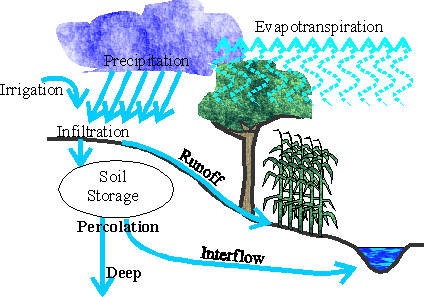- Base Flow – occurs when the stored groundwater raises the water table elevation above that of an adjacent ditch or stream. When this occurs, the hydraulic head of the water table begins to exceed that of the adjacent stream, and the groundwater flows to recharge the stream.
- In a perennial stream (always flowing), base flow is a continuous process of transferring temporarily stored groundwater into surface water.
- For an intermittent stream (one that only flows part of the year), the groundwater is stored until the deep percolation recharge raises the water table, and then the excess groundwater is transferred to the stream causing it to flow.
- Storm Flow – is most often considered to be the direct surface water runoff that flows to and recharges a stream following a precipitation event. Some hydrologists, however, consider storm flow as both the direct surface water runoff plus the increase in base flow (over pre-storm event) that occurs in a stream in response to a rain event.
- The distinction and separation of storm flow and base flow in a stream is very important to stream water quality, as the quality of the storm flow and the base flow is usually quite different. An ephemeral stream is one that flows only during and immediately after a rain event, carrying only surface water runoff with no base flow contribution. This type of stream channel is above the water table at all times. The term concentrated flow path is often used in reference to a channel carrying only storm flow.
- Runoff (Surface, Channel and Subsurface) – varies from point to point in a stream within a watershed. Since these different sources of runoff contribution to a stream can vary, the water quality of a stream can vary substantially from one location to another.
- Runoff tends to accumulate as one approaches the outlet of a watershed, and larger watersheds generally exhibit more runoff. Land use can greatly impact the different components of runoff, and subsequently the water quality of the stream(s) within the watershed. Large areas of impervious surface will increase the surface runoff component by reducing the opportunity for infiltration, percolation, and storage.
- Converting large areas of forest to other land uses often increases surface runoff by changing interception and evapotranspiration, and perhaps infiltration and percolation components. Channel alterations and modifications impact the amount of channel storage.
- Evaporation and Transpiration – varies spatially in watersheds with respect to the extent of open water, types of vegetation, and impervious surfaces. Even more importantly, evaporation and transpiration vary temporally (or seasonally throughout the year), causing major shifts in retention and runoff.
|

